
Asteroids is a space-themed multidirectional shooter arcade video game designed by Lyle Rains and Ed Logg released in November 1979 by Atari, Inc. The player controls a single spaceship in an asteroid field which is periodically traversed by flying saucers. The object of the game is to shoot and destroy the asteroids and saucers, while not colliding with either, or being hit by the saucers' counter-fire. The game becomes harder as the number of asteroids increases.
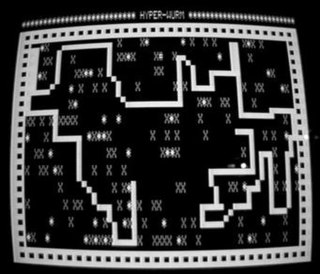
Snake is a genre of action video games where the player maneuvers the end of a growing line, often themed as a snake.

Breakout is an arcade video game developed and published by Atari, Inc. and released on May 13, 1976. It was designed by Steve Wozniak, based on conceptualization from Nolan Bushnell and Steve Bristow, who were influenced by the seminal 1972 Atari arcade game Pong. In Breakout, a layer of bricks lines the top third of the screen and the goal is to destroy them all by repeatedly bouncing a ball off a paddle into them. The arcade game was released in Japan by Namco. Breakout was a worldwide commercial success, among the top five highest-grossing arcade video games of 1976 in both the United States and Japan and then among the top three highest-grossing arcade video games of 1977 in the US and Japan. The 1978 Atari VCS port uses color graphics instead of a monochrome screen with colored overlay.
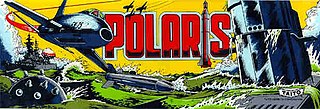
Polaris is a fixed shooter arcade video game released in 1980 by Taito. The player controls a submarine which can shoot missiles upward. The goal is to destroy all of the airplanes in each level while avoiding bombs dropped from the aircraft, as well as mines launched by enemy submarines and depth charges dropped from boats that speed by. Versions for the Atari 2600 and VIC-20 were released by Tigervision in 1983.

Depthcharge is a black-and-white submarine simulator arcade video game released in 1977 by Gremlin Industries. The game shows a side view of a section of ocean with a destroyer on the surface and submarines passing beneath it. The player-controlled destroyer can be moved left and right and drop depth charges to destroy the submarines below.

Air-Sea Battle is a fixed shooter developed and published by Atari, Inc. for the Atari VCS. Air-Sea Battle is partially based on the 1975 Atari arcade video game Anti-Aircraft where each player uses a ground-based gun to shoot passing aircraft. The cartridge adds other variants, such as planes dropping bombs on ships and a carnival-themed shooting gallery.

Anteater is an arcade video game designed by Chris Oberth and released in 1982 by Tago Electronics. The player steers the tongue of the eponymous creature through a maze, retracting it when dangers approach. Though the arcade game was not a hit, it spawned a number of direct clones for home computers; Sierra's Oils Well became better known than the original. Oberth wrote an Apple II version of his own game for Datamost using a different title.

Armored Car is an overhead view maze arcade video game released by Stern Electronics in 1981. The player drives an armored car as the maze scrolls from right to left, collecting money, and avoiding criminals.
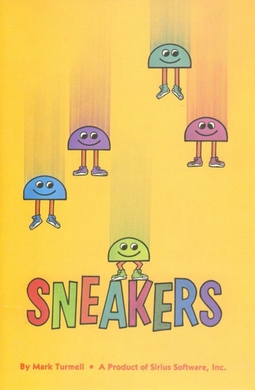
Sneakers is a fixed shooter video game for the Apple II written by Mark Turmell and published by Sirius Software in 1981. A version for Atari 8-bit computers was released the same year. Sneakers was Turmell's first published game. He later was the lead designer and programmer of 1993's NBA Jam.

Nautilus is a video game for Atari 8-bit computers created by Mike Potter and published by Synapse Software in 1982. The players control a submarine, the Nautilus, or a destroyer, the Colossus, attempting to either destroy or rebuild an underwater city. The game the first to feature a "split screen" display to allow both players to move at the same time.

Sea Wolf is an arcade video game designed by Dave Nutting and released by Midway in 1976. It is a video game update of an electro-mechanical Midway game, Sea Devil, itself based on Sega's 1966 electro-mechanical arcade submarine simulator Periscope. The game was released in Japan by Taito. In Sea Wolf, the player, piloting an unseen submarine, launches torpedoes vertically in an attempt to sink ships moving horizontally across the screen before time runs out. The screen is viewed through a faux periscope mounted on the cabinet.

Destroyer is a naval combat simulation video game published by Epyx in 1986 for the Amiga, Apple II, Commodore 64, and IBM PC compatibles.
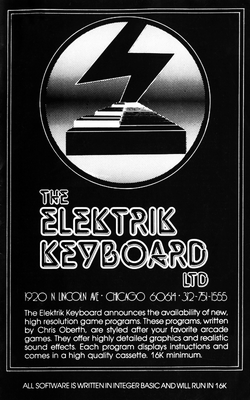
The Elektrik Keyboard was a computer and musical instrument store located on North Lincoln Avenue in Chicago, Illinois in the 1970s and 1980s. In the late '70s it added personal computers to its lineup, and began publishing Apple II computer software written by programmer Chris Oberth. The software, advertised in the company's catalog and sold on cassette, largely consisted of games including some that emulated popular arcade titles.
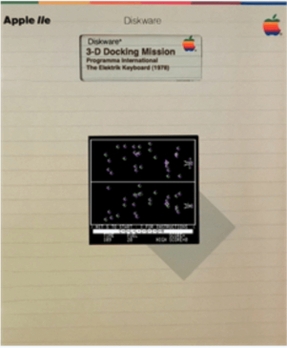
3-D Docking Mission is a simulation game for the Apple II written by Chris Oberth. The game was published by Programma International and The Elektrik Keyboard of Chicago, Illinois in 1978.
Christian H. "Chris" Oberth was a video game programmer who began writing games for the Apple II in the late 1970s. He also developed handheld electronic games for Milton Bradley, arcade video games for Stern Electronics and other companies, and ported games to home computers and consoles.
Phasor Zap is a game for the Apple II programmed by Chris Oberth and published in 1978 by The Elektrik Keyboard of Chicago, Illinois.

Deep Scan is a color arcade video game released in 1979 by Sega. The player controls a battleship on the surface of the ocean attempting to destroy submarines below it. It is a submarine simulator similar to Periscope (1965), Sea Wolf (1976) and Depthcharge (1977). Some arcade cabinets also include Invinco, a Space Invaders clone released by Sega the same year.

Speed Race is a 1974 arcade racing video game developed and manufactured by Taito and released under the titles Racer and Wheels in North America by distributor Midway Manufacturing in 1975. Designed by Tomohiro Nishikado, the gameplay involves the player using the attached steering wheel to maneuver a car alongside a fast vertical scrolling road. The objective is to score points by driving past other cars without colliding with them; more points are awarded for driving faster. Players must do this under a 90-second time limit, which ends the game when it runs out. The gameplay concepts were adapted from two earlier driving electro-mechanical games: Kasco's Mini Drive (1958) and Taito's Super Road 7 (1970).

Destroyer is a single-player arcade game developed and published by Atari, Inc. in 1977. The player attempts to sink ships and destroy submarines from the perspective of a naval destroyer.
Rescue is a twin-stick shooter designed by Chris Oberth and released by Stern as an arcade video game in 1982. The player flies a helicopter over the open sea to rescue stranded paratroopers from enemy forces and sharks. As the player-controlled helicopter flies left and right, the cloud layers move at different rates, giving a parallax scrolling effect.

















